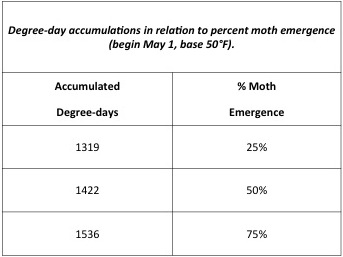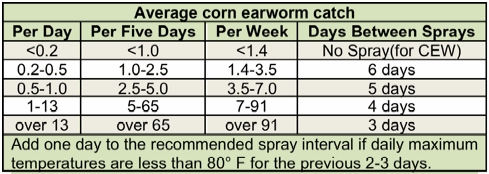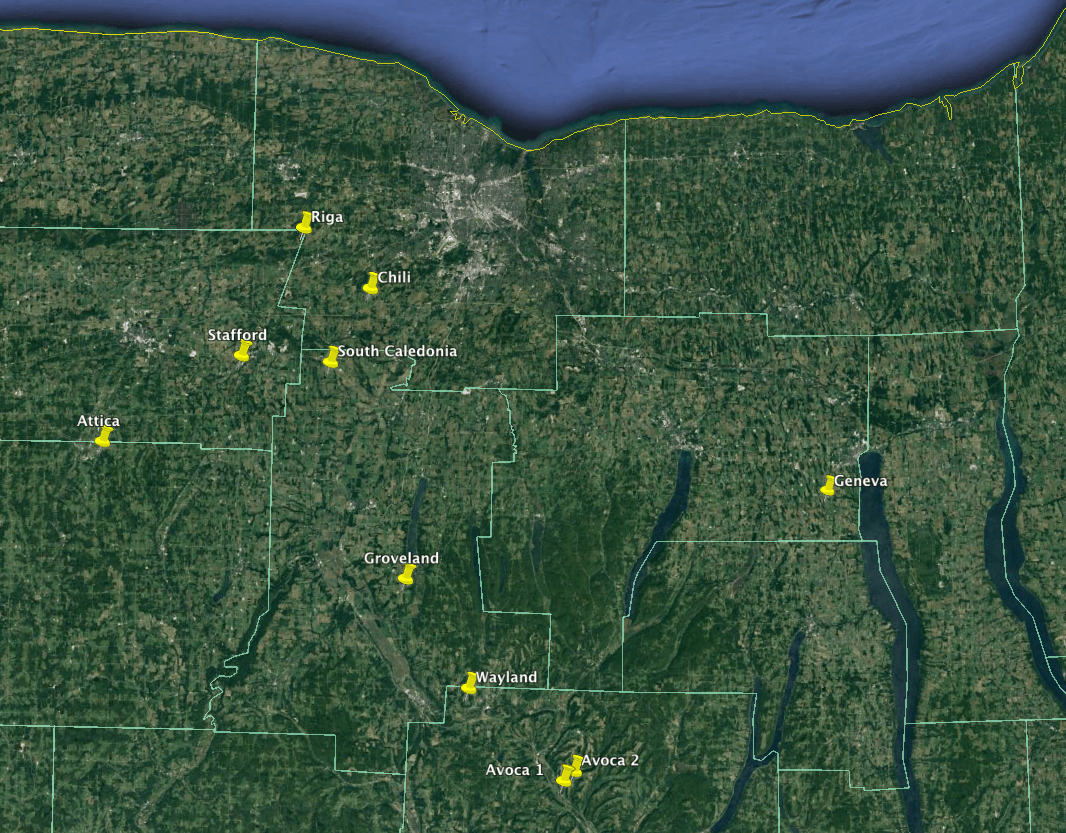Thirty-four of 38 sites reported this week. European corn borer (ECB)-E was caught at 11 sites and ECB-Z was caught at 7 sites. Corn earworm was caught at 16 sites with 11 sites high enough to be on a 4, 5, or 6 day spray schedule (see table below). Fall armyworm (FAW) was caught at 8 sites and Western bean cutworm (WBC) continues to increase, with 28 sites reporting catches with the highest catch in Pavilion at 164.
WBC trap catches will most likely peak over the next two weeks. According to data from the University of Nebraska, 50% of WBC emerge when the accumulated degree-days (base 50) reach 1422 (see chart below). It is also recommended that scouting begins when cumulative trap catches reach 100 moths, however egg masses have been found when trap catches are in the single digits. The threshold for fresh market sweet corn is only 1%. It is important to scout late whorl and early tassel-emergence fields as these are most at risk. After hatching larvae will spend a few days feeding on the tassel before moving down to the ear. Most insecticide sprays used to control ECB will also control WBC.
| Location | ECB-E | ECB-Z | CEW | FAW | WBC | DD to Date |
|
| Accord (Ulster Co.) | 1 | 0 | 3 | NA | 1 | 1454.1 | |
| Amsterdam (Fulton Co.) | 0 | 11 | 0 | 0 | 51 | 1392.7 | |
| Athens (Greene Co.) | 0 | 0 | 5 | 0 | 8 | 1587.1 | |
| Avon (Livingston Co.) | 0 | 0 | 2 | 0 | 39 | 1405.7 | |
| Baldwinsville (Onondaga Co.) | 0 | 0 | 4 | 0 | 41 | 1469.6 | |
| Batavia (Genesee Co.) | 0 | 17 | 0 | 0 | 12 | 1471.3 | |
| Bellona (Yates Co.) | 0 | 0 | 1 | 1 | 50 | 1511.6 | |
| Eagle Bridge (Washington Co.) | NA | NA | NA | NA | NA | 1250.5 | |
| Eden (Erie Co.) | 1 | 0 | 0 | 1 | 56 | 1424.5 | |
| Farmington (Ontario Co.) | 1 | 1 | 0 | 0 | 4 | 1391.7 | |
| Feura Bush (Albany Co.) | 0 | 1 | 2 | 0 | 3 | 1408.6 | |
| Florida (Orange Co.) | 0 | 0 | 24 | 1 | 8 | 1531.0 | |
| Geneva (Ontario Co.) | 17 | 0 | 0 | 0 | 0 | 1454.8 | |
| Greenwich (Washington Co.) | NA | NA | NA | NA | NA | 1250.5 | |
| Hamlin (Monroe Co.) | NA | NA | NA | NA | NA | 1360.7 | |
| Hurley (Ulster Co.) | 0 | 0 | 2 | 0 | 2 | 1516.8 | |
| Kennedy (Chautauqua Co.) | 0 | 0 | 0 | 0 | 23 | 1291.0 | |
| Kinderhook (Columbia Co.) | 3 | 0 | 5 | 0 | 15 | 1514.4 | |
| King Ferry (Cayuga Co.) | 0 | 0 | 1 | 0 | 6 | 1464.1 | |
| Kirkville (Madison Co.) | 5 | 0 | 1 | 1 | 4 | 1440.0 | |
| New Paltz (Ulster Co.) | 0 | 0 | 2 | NA | 1 | 1455.9 | |
| Oswego (Oswego Co.) | 0 | 0 | 0 | 0 | 64 | 1385.3 | |
| Owego (Tioga Co.) | 8 | 0 | 0 | 0 | 0 | 1262.5 | |
| Pavilion (Genesee Co.) | 0 | 0 | 0 | 2 | 164 | 1174.4 | |
| Penn Yan (Yates Co.) | 0 | 0 | 0 | 1 | 12 | 1497.5 | |
| Peru (Clinton Co.) | 0 | 0 | 0 | 0 | 17 | 1284.6 | |
| Plattsburgh (Clinton Co.) | 0 | 0 | 0 | 0 | 1 | 1285.7 | |
| Plessis (Jefferson Co.) | 0 | 0 | 0 | 0 | 40 | 1344.5 | |
| Preble (Cortland Co.) | 0 | 0 | 0 | 0 | 23 | 1396.4 | |
| Ransomville (Niagara Co.) | 0 | 0 | 5 | 1 | 15 | 1510.1 | |
| Schaghticoke (Rensselear Co.) | 0 | 0 | 1 | 0 | 8 | 1546.3 | |
| Seneca Castle (Ontario Co.) | 1 | 0 | 0 | 1 | 6 | 1392.7 | |
| Sharon Springs (Schoharie Co.) | 0 | 0 | 0 | 0 | 0 | 1436.2 | |
| Sherwood (Cayuga Co.) | 1 | 1 | 1 | NA | NA | 1464.1 | |
| South Colton (St. Lawrence Co.) | 16 | 1 | 0 | 0 | 63 | 1107.0 | |
| Stone Ridge (Ulster Co.) | 1 | 0 | 2 | NA | NA | 1516.8 | |
| Tivoli (Dutchess Co.) | 0 | 1 | 0 | NA | NA | 1549.5 | |
| Williamson (Wayne Co.) | NA | NA | NA | NA | NA | 1312.8 | |
| ECB – European Corn Borer CEW – Corn Earworm FAW – Fall Armyworm WBC – Western Bean Cutworm NA – not available DD – Degree Day (base 50F) accumulation since May 1st according to nearest NEWA station |
|||||||
| trap catches for the week of 7.17.18 – 7.24.18 |
|||||||
This week I am including trap catch data from WBC traps set up near dry bean fields.
Dry Bean Western Bean Cutworm Alert
7.24.18
Marion Zuefle, NYS IPM Program
(Alert modified from Carol McNeil)
(Information and photos from T. Baute, OMAFRA)
This year we are monitoring ten WBC traps placed next to dry bean fields. The location of the traps are given in the image below. Dry bean growers should scout adjacent corn for WBC eggs and larvae when cumulative trap catch reaches 100 moths. Both the Avoca 2 and Riga sites reached the 100 cumulative moth threshold this week (see table below for trap catches) and 3 WBC egg masses were found in the adjacent corn field in Riga. Peak WBC flight historically occurs the first week of August. All dry bean growers should begin scouting pods for WBC feeding about 10 days after peak flight regardless of cumulative trap catch, and should continue to scout for three weeks, especially if damage has been seen in recent years.
Check 10 random spots in a field, 5 plants per spot. Inspect all the pods on the plants looking for holes. Surface feeding can be caused by other insects. WBC will mine directly into the pod and will often feed on the seed inside. European corn borer will also feed inside the pod and would most likely still be present. If there is damage going directly into the pod and seed but no larva present, it is quite possibly WBC. During the day WBC larva are not actively feeding in the pod, instead they drop to the soil and will remain there until night. Fresh damage will be green, not brown.
If you have questions contact Marion Zuefle at mez4@cornell.edu or 315-787-2379.
This project is funded by the NYS Dry Bean Industry.
| Dry Bean Location | 7.3.18 | 7.10.18 | 7.17.18 | 7.24.18 | Cumulative WBC | ||
| Attica (Wyoming Co.) | 2 | 4 | 32 | NA | 38 | ||
| Avoca 1 (Steuben Co.) | NA | 0 | 2 | 37 | 39 | ||
| Avoca 2(Steuben Co.) | NA | 2 | 30 | 101 | 133 | ||
| Caledonia South (Livingston Co.) | 0 | 0 | 6 | 30 | 36 | ||
| Chili (Monroe Co.) | 0 | 1 | 8 | 54 | 63 | ||
| Geneva (Ontario Co.) | 0 | 0 | 4 | 24 | 28 | ||
| Groveland (Livingston Co.) | 0 | 0 | 5 | 76 | 81 | ||
| Riga (Monroe Co.) | 0 | 5 | 54 | 146 | 205 | ||
| Stafford (Genesee Co.) | 1 | 0 | 8 | 83 | 92 | ||
| Wayland (Steuben Co.) | NA | 2 | 3 | 11 | 16 | ||
| Western Bean Cutworm trap counts by date NA – not available |
|||||||



